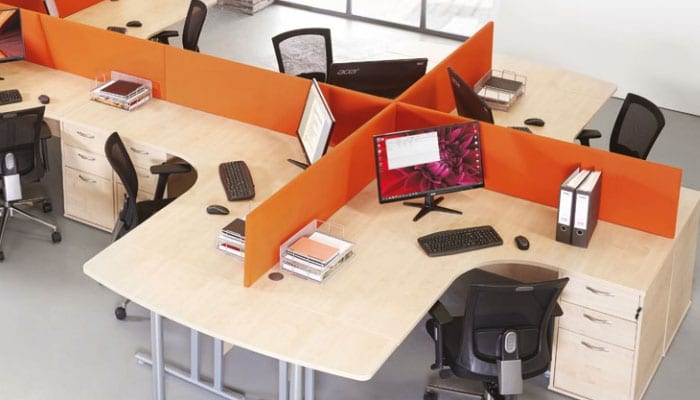Furniture is a key element within any office, not only providing comfort for employees, but also aiding professionalism. The importance of office furniture should never be underestimated, as it can make or break your workplace efficiency.
As the centrepiece of your office, when considering your office furniture you should take into account suitability for its main function. For example, office workers are at particular risk of developing back pain due to unsatisfactory seating, so don’t be one of those companies whose workers are going off sick as a result.

How serious is back pain among UK office workers?
Lower back pain is a major health problem that affects up to 38% of office employees. Normally, it will begin within one year of sitting in the wrong position at work. It has become the most common cause of work-related health issues in people aged under 45 years.
It is also the most expensive health-related cause of problems in the workplace, in terms of lost working hours. According to the UK Statistics Authority, a staggering 10 million working days are lost every year due to employees calling in sick with back pain!
In terms of sick pay, lost income for the business, medical expenses and compensation for employees suffering long-term back issues caused by their job, it costs the UK an estimated £1 billion per year.
The average person spends at least four hours a day on a computer (probably more in many cases), so unless they’re sitting in the correct position, this can have far-reaching effects on their health – not to mention the nation’s economy too!
What should businesses consider when buying office furniture?
The main consideration is the comfort of every piece of office furniture and how well it adapts to the day-to-day tasks of the employees. Seating is highly important, since these days, it’s not uncommon for people to sit for eight or nine hours a day at their desk.
Chairs must be comfortable, improve productivity and offer great functionality when being used for long periods. It’s possible to achieve this, without having to compromise on style. While office chairs need to be comfortable, they can also be aesthetically pleasing.
Available in a wide variety of colours, styles and upholstery finishes including fabric, leather and mesh, they can also offer additional functions such as being fully adjustable, delivering comfort and improving efficiency, even in the most demanding of office environments.
What are the best types of office furniture?
As well as choosing the most suitable chairs, both in terms of functionality and comfort, every item of office furniture must work together to create the optimum office environment. Having great chairs is no use without suitable desks to go with them!
A popular option is the bench desk system, offering a flexible approach to office furniture design. With matching desking for individual workers, meeting tables and executive desks, this style is practical, while at the same time providing an integrated look for added professionalism.
While modular bench solutions are becoming ever more popular as a cost-effective option, traditional panel leg desking has been brought up-to-date with a fresh approach, combining modern colour finishes, such as white and walnut, with panel-end leg design.
Never forget the importance of your reception area furniture. As well as keeping employees comfortable, this is the first impression visitors have of your business. Making sure it looks smart, professional and welcoming is crucial, as first impressions count.
What about storage space?
You can never have too much storage space in your office, so whether you go for traditional wooden storage, or contemporary steel storage, make sure it meets the long-term needs of your office.
It must be high quality, stylish and robust enough to suit the most demanding working environments. Storage cabinets are ideal for offices, for backroom storage of employee belongings, and for general office supplies and stationery.
Finally, make sure your communal areas, such as the dining area, have functional and comfortable chairs and tables. Employees need timely breaks and should be able to relax at lunchtime. They will then return to the office feeling refreshed, enabling them to work in a more productive manner for the rest of the day.
How has Covid-19 affected the office space?
While office space should always be properly managed, making the most use of the available space and ensuring it permits efficient workplace interactions, businesses have had to further adapt to ensure employees can work safely due to the ongoing Covid-19 pandemic.
Most people worked from home when the UK lockdown began in March, but now that they’re returning to the workplace, businesses are having to reconsider office furniture to help with social distancing rules.
Many companies will have to redesign spaces to ensure physical distancing is observed and to restrict movements in congested areas. Screens may have to be erected in places and desks will have to be repositioned so employees aren’t sitting too close to each other face-to-face.
The office experience probably won’t be as it was before the pandemic for the foreseeable future. It looks set to constantly evolve, as the official health advice continually changes – so be prepared to keep up to speed with the regulations!
